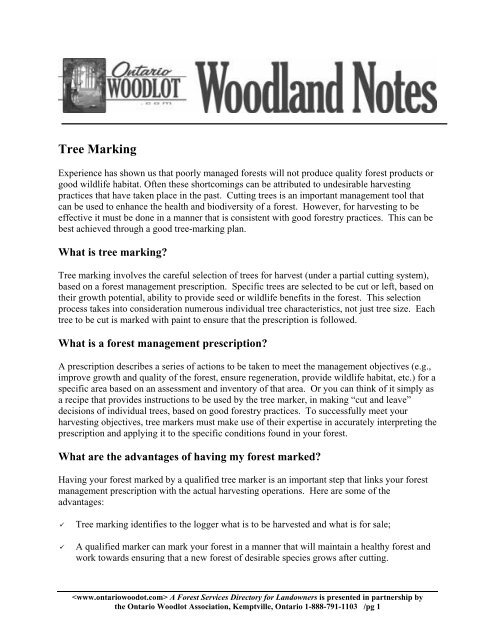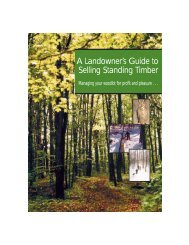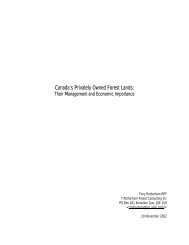Tree Marking - Ontario woodlot.com
Tree Marking - Ontario woodlot.com
Tree Marking - Ontario woodlot.com
Create successful ePaper yourself
Turn your PDF publications into a flip-book with our unique Google optimized e-Paper software.
<strong>Tree</strong> <strong>Marking</strong><br />
Experience has shown us that poorly managed forests will not produce quality forest products or<br />
good wildlife habitat. Often these short<strong>com</strong>ings can be attributed to undesirable harvesting<br />
practices that have taken place in the past. Cutting trees is an important management tool that<br />
can be used to enhance the health and biodiversity of a forest. However, for harvesting to be<br />
effective it must be done in a manner that is consistent with good forestry practices. This can be<br />
best achieved through a good tree-marking plan.<br />
What is tree marking?<br />
<strong>Tree</strong> marking involves the careful selection of trees for harvest (under a partial cutting system),<br />
based on a forest management prescription. Specific trees are selected to be cut or left, based on<br />
their growth potential, ability to provide seed or wildlife benefits in the forest. This selection<br />
process takes into consideration numerous individual tree characteristics, not just tree size. Each<br />
tree to be cut is marked with paint to ensure that the prescription is followed.<br />
What is a forest management prescription?<br />
A prescription describes a series of actions to be taken to meet the management objectives (e.g.,<br />
improve growth and quality of the forest, ensure regeneration, provide wildlife habitat, etc.) for a<br />
specific area based on an assessment and inventory of that area. Or you can think of it simply as<br />
a recipe that provides instructions to be used by the tree marker, in making “cut and leave”<br />
decisions of individual trees, based on good forestry practices. To successfully meet your<br />
harvesting objectives, tree markers must make use of their expertise in accurately interpreting the<br />
prescription and applying it to the specific conditions found in your forest.<br />
What are the advantages of having my forest marked?<br />
Having your forest marked by a qualified tree marker is an important step that links your forest<br />
management prescription with the actual harvesting operations. Here are some of the<br />
advantages:<br />
! <strong>Tree</strong> marking identifies to the logger what is to be harvested and what is for sale;<br />
! A qualified marker can mark your forest in a manner that will maintain a healthy forest and<br />
work towards ensuring that a new forest of desirable species grows after cutting.<br />
A Forest Services Directory for Landowners is presented in partnership by<br />
the <strong>Ontario</strong> Woodlot Association, Kemptville, <strong>Ontario</strong> 1-888-791-1103 /pg 1
! Not all trees are created equal and a small tree is not always a younger tree. Many of the<br />
small trees in your <strong>woodlot</strong> are small because of their age. However, the size of a tree may<br />
also be due to poor genetics, stunted growth or site characteristics. It takes years of<br />
experience to tell the difference, and an experienced tree marker can provide you with this<br />
expertise.<br />
! <strong>Tree</strong> markers can identify the trees in the <strong>woodlot</strong> that should be retained to provide<br />
valuable wildlife habitat and to maintain biodiversity (e.g., cavity trees).<br />
! <strong>Tree</strong> marking, based on sound forest management principles, will optimize your economic<br />
return and enhance future timber quality and quantity (to ensure a continuous and<br />
predictable supply of timber products and source of revenue); and<br />
! <strong>Tree</strong> marking done in conjunction with good forestry practices has the capacity to ensure the<br />
long-term sustainability of your forest.<br />
What are the limitations of tree marking?<br />
<strong>Tree</strong> marking alone will not prevent “high-grading” (where the largest most valuable trees are<br />
cut leaving behind the less valuable or poorer quality trees in the forest). Virtually anyone with<br />
a can of spray paint can sell their services as a tree marker. It is only when tree marking is<br />
applied in conjunction with good forestry practices that the opportunity for high-grading can be<br />
minimized.<br />
Why is tree marking not based solely on tree diameter?<br />
A harvest based solely on cutting the biggest and the best trees (diameter cutting) can easily be<br />
considered a high-grade operation. There are five good reasons to follow a forest management<br />
prescription vs. a diameter limit cut.<br />
Financial Returns – diameter limit cutting reduces the long-term financial benefits that can be<br />
derived from a managed <strong>woodlot</strong>. Under this system, most trees greater than 30 cm in diameter<br />
are harvested. Many of these trees would respond well to thinning and could produce a very<br />
high rate of return to the landowner if left to grow to maturity.<br />
Future Growth – the thinning provided by a diameter limit cut is not uniform. It is simply a<br />
result of cutting where there are large trees. As a result, some areas of the forest which had large<br />
trees are cut heavily, while other areas of small trees are not cut at all.<br />
In the uncut areas, the forest will continue to grow slowly because of overcrowding, and the<br />
financial benefits of thinning will not be achieved. Poor quality, small diameter trees with no<br />
potential to develop into sawlogs should be cut and removed from the forest to increase growth<br />
of the remaining timber-quality trees. In most areas of the province there are markets for<br />
fuelwood and pulpwood to permit sale of these smaller trees.<br />
A Forest Services Directory for Landowners is presented in partnership by<br />
the <strong>Ontario</strong> Woodlot Association, Kemptville, <strong>Ontario</strong> 1-888-791-1103 /pg 2
In areas that are cut too heavily, there will be insufficient large trees to capture the increased<br />
light, moisture and nutrients available from thinning. As a result, growth will occur largely on<br />
young seedlings. In addition, those trees which remain behind may not be of high sawlog<br />
potential. The lumber-producing capability of the forest will be reduced significantly.<br />
Heavy cutting also results in a loss of potential value of the smaller but high-value trees, which<br />
are left behind. <strong>Tree</strong>s less than 30 cm in diameter tend to have branches located low on the stem.<br />
In an uncut or managed forest, a sufficient number of trees are present to shade these young<br />
trees, causing the lower branches to fall off due to a lack of sunlight. This will result in an<br />
increase in the “clear length” of the tree over time (the length of the bole with no branches), with<br />
a resulting increase in high-quality, knot-free logs for lumber. After a heavier cut, these small<br />
trees are exposed to much more sunlight. As a result, they tend to keep their lower limbs and<br />
lose the potential to develop further clear length. In fact, many trees may develop new branches<br />
on the trunk after heavy cutting, which actually will reduce their clear length and future value.<br />
Forest Regeneration – a forest management prescription can be prepared to ensure that a new<br />
forest of desirable species grows after cutting. For instance, sufficient red oak and white pine<br />
trees can be left for seed and cover to enhance the regeneration of high-value oak and pine<br />
seedlings. In a diameter limit cut, the forest generally regenerates to whatever young trees are<br />
present on the forest floor at the time of cutting. Such procedures rarely result in the regeneration<br />
of an oak or pine forest. On the contrary, the open conditions, resulting from heavy cutting,<br />
often favor the regeneration of low-value timber species like poplar.<br />
Wildlife Values – landowners may wish to leave some trees in their forest to provide highquality<br />
wildlife habitat (including nesting sites, mast and cover). These values must be<br />
addressed in the forest management prescription.<br />
<strong>Tree</strong>-Cutting Bylaws or <strong>Tree</strong> Conservation Bylaws – in some municipalities, diameter limit<br />
cutting is a contravention of local tree-cutting bylaws and is not in accordance with good forestry<br />
practices.<br />
Where should the markings be applied?<br />
<strong>Tree</strong>s should be marked at breast height (with a painted band around the bole) and at the base<br />
(butt) of each tree, extending from ground level up approximately 30-40 cm. The band at breast<br />
height makes the marked trees easy to see from all angles in the forest. The butt mark provides<br />
an indicator that can be used to ensure that only marked trees have been removed during harvest.<br />
Yellow paint is used in most harvesting operations (on private land) to identify the trees to be<br />
cut. Blue paint is used to identify trees to be retained (e.g., for wildlife habitat) and red paint is<br />
used to identify property boundaries. Check with your logger to ensure that there is a clear<br />
understanding of the colour scheme being used to mark the trees in your forests.<br />
What is a certified tree marker?<br />
A Forest Services Directory for Landowners is presented in partnership by<br />
the <strong>Ontario</strong> Woodlot Association, Kemptville, <strong>Ontario</strong> 1-888-791-1103 /pg 3
Since 1995, the <strong>Ontario</strong> Ministry of Natural Resources (MNR) has provided tree marking<br />
certification training. The training involves a one-week course covering silvicultural systems,<br />
silviculture, silvics, wildlife habitat, tree defects and tree vigour characteristics. Participants are<br />
field tested, and successful trainees are issued a certificate endorsing their skills as a certified tree<br />
marker (of conifer forests, hardwood forests or both). To maintain MNR’s certification, a tree<br />
marker must attend and successfully <strong>com</strong>plete a two-day refresher course every three years.<br />
Why hire a certified tree marker?<br />
It is important to realize that a tree marker’s skills play a significant role in the decision-making<br />
process (when identifying which tree should be removed from your forest during harvest<br />
operations). Their decisions can directly influence the long-term economic and ecological<br />
integrity of your forest. For this reason, a good tree marker must be knowledgeable and skilled.<br />
They must be able to properly assess a tree’s quality and vigour, its value in terms of grade and<br />
product and its potential as a tree for wildlife habitat or for maintaining biodiversity.<br />
Hiring a certified tree marker ensures a proven level of <strong>com</strong>petency in carrying out this<br />
important task. However, experience can also be important. For example, you may wish to hire a<br />
certified tree marker who has several years of experience in marking hardwood forests if your<br />
<strong>woodlot</strong> is predominantly hardwood.<br />
Where to get help?<br />
<br />
Looking for more information? You may want to read one of the following guides.<br />
- Promoting a Healthy Forest through <strong>Tree</strong> <strong>Marking</strong> NEW! <br />
- <strong>Tree</strong>-<strong>Marking</strong> Guide for the Tolerant Hardwoods Working Group in <strong>Ontario</strong> NEW! <br />
Additional assistance can be obtained from local forest consultants and it may also be<br />
helpful to join your local <strong>woodlot</strong> association and benefit from other landowners' knowledge and experience.<br />
© 2003, <strong>Ontario</strong> Woodlot Association<br />
A Forest Services Directory for Landowners is presented in partnership by<br />
the <strong>Ontario</strong> Woodlot Association, Kemptville, <strong>Ontario</strong> 1-888-791-1103 /pg 4

















